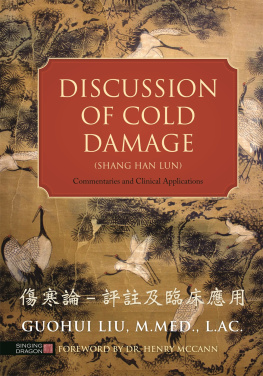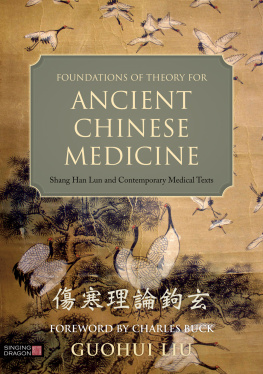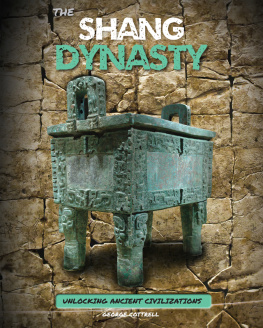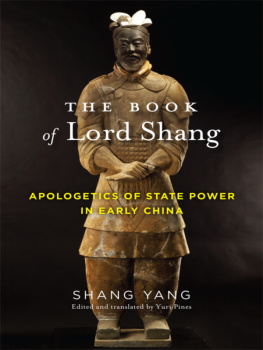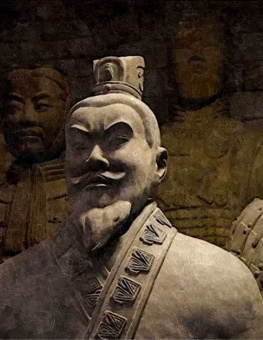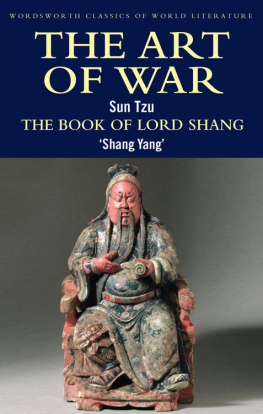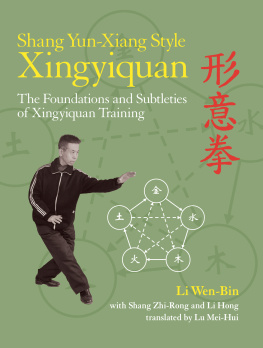
DISCUSSION OF COLD DAMAGE
(SHANG HAN LUN)
by the same author
Foundations of Theory for Ancient Chinese Medicine
Shang Han Lun and Contemporary Medical Texts
Guohui Liu
ISBN 978 1 84819 262 1
eISBN 978 0 85701 211 1
of related interest
Acupuncture and Chinese Medicine
Roots of Modern Practice
Charles Buck
Foreword by Barbara Kirschbaum
ISBN 978 1 84819 159 4
eISBN 978 0 85701 133 6
Heavenly Stems and Earthly BranchesTianGan DiZhi
The Heart of Chinese Wisdom Traditions
Master Zhongxian Wu and Dr Karin Taylor Wu
Foreword by Fei BingXun
ISBN 978 1 84819 151 8
eISBN 978 0 85701 158 9
Gold Mirrors and Tongue Reflections
The Cornerstone Classics of Chinese Medicine Tongue Diagnosis
The Ao Shi Shang Han Jin Jing Lu, and the Shang Han She Jian
Ioannis Solos
Forewords by Professor Liang Rong and Professor Chen Jia-xu
ISBN 978 1 84819 095 5
eISBN 978 0 85701 076 6
Essential Texts in Chinese Medicine
The Single Idea in the Mind of the Yellow Emperor
Richard Bertschinger
ISBN 978 1 84819 162 4
eISBN 978 0 85701 135 0
DISCUSSION OF
COLD DAMAGE
(SHANG HAN LUN)
Commentaries and Clinical Applications
GUOHUI LIU, M.M ed ., L.A c.
Foreword by Dr. Henry McCann

LONDON AND PHILADELPHIA
First published in 2016
by Singing Dragon
an imprint of Jessica Kingsley Publishers
73 Collier Street
London N1 9BE, UK
and
400 Market Street, Suite 400
Philadelphia, PA 19106, USA
www.singingdragon.com
Copyright Guohui Liu 2016
Foreword copyright Henry McCann 2016
All rights reserved. No part of this publication may be reproduced in any material form (including photocopying or storing it in any medium by electronic means and whether or not transiently or incidentally to some other use of this publication) without the written permission of the copyright owner except in accordance with the provisions of the Copyright, Designs and Patents Act 1988 or under the terms of a licence issued by the Copyright Licensing Agency Ltd, Saffron House, 610 Kirby Street, London EC1N 8TS. Applications for the copyright owners written permission to reproduce any part of this publication should be addressed to the publisher.
Warning: The doing of an unauthorised act in relation to a copyright work may result in both a civil claim for damages and criminal prosecution.
Library of Congress Cataloging in Publication Data
Liu, Guohui, 1956- , author, translator.
Discussion of cold damage (Shang han lun) : commentaries and clinical applications / [translation and commentary by] Guohui Liu.
p. ; cm.
Includes bibliographical references and index.
ISBN 978-1-84819-254-6 (alk. paper)
I. Zhang, Zhongjing, active 168-196. Shang han lun. Translation of (work): II. Title.
[DNLM: 1. Zhang, Zhongjing, active 168-196. Shang han lun. 2. Medicine, Chinese Traditional. 3.
Drugs, Chinese Herbal--therapeutic use. 4. Signs and Symptoms. WZ 294]
RS180.C5
615.3210951--dc23
2014047512
British Library Cataloguing in Publication Data
A CIP catalogue record for this book is available from the British Library
ISBN 978 1 84819 254 6
eISBN 978 0 85701 200 5
Printed and bound in Great Britain
CONTENTS
FOREWORD
The Shang Han Lun is one of the most influential medical texts ever written. Since the Song Dynasty (9601279 CE ) it has practically defined the elite practice of medicine by Confucian literati, and as such is one of the texts on which the modern practice of Chinese medicine firmly rests. The Shang Han Lun is also the most important formula text to describe the use of diagnosis and treatment based on pattern diagnosis. This approach to medicine allows (and even mandates) the physicians flexible modification of treatment based on the ever-changing complexities of clinical pictures. One of the most beautiful things about this classic is its ability to offer solutions for complex clinical presentations using simple and direct formulae with small numbers of ingredients. This elegance constantly amazes me as I use these very old formulae to treat very modern diseases. In my opinion, no other formula text does this as effectively.
As a teacher of Chinese medical classics I can attest to the fact that these books are neither easy to read nor easy to transmit to students. This is one of the reasons they were chosen by Confucian physicians to represent their tradition as something distinct and superior to that of common doctors of their day. The Shang Han Lun in particular, as opposed to classics such as the Huang Di Nei Jing , is very, very terse. This terse language does two thingsit makes it an incredibly flexible source of medical information and it also makes the lines quite difficult to read and interpret in many sections. The book was written in a classical language that is quite dissimilar to modern vernacular, so even native Chinese speakers (from both the Song Dynasty and from modern times) have great difficultly penetrating the received lines and rendering them meaningful for clinical practice.
So, here we have a quandary. How can we take a book that was first written or compiled nearly 2000 years ago, that was adopted about 1000 years ago as a defining text for medical practice, and make it something alive and relevant for todays physicians? Moreover, how can we possibly expect this if the text is written in an archaic language that does not resemble any modern spoken language? This tall order is exactly what my colleague and former teacher Dr. Liu has accomplished.
There are many features of this book that make it an important contribution to English language publications on Chinese medicine and in addition set a higher standard for other works yet to come. First is Dr. Lius thoughtful translation of the actual lines of text. Here readers will find the text in the original classical Chinese (using fan ti zi , the original complex characters) followed by its Hanyu Pinyin Romanization, and then the translation into English. This feature is extremely useful. When I was first completing my Chinese medicine training, having previously lived in Japan as a graduate student, I was one of the only non-Asian students who spoke any Asian language. One of my early frustrations with studying the medicine was that practically all of the books used in training American students had no original Chinese or Japanese text at all. How could I be sure for myself that the translations given to me were accurate or useful? In retrospect I can firmly say they sometimes were not.
As my own interest in the medicine grew, alongside my frustrations about the issues of authenticity and accuracy in translation from Asian to European languages, I decided I would have to take up the study of Chinese language as well as my previous study of Japanese. Over my years of practice and teaching I found I was not alone, and each year more and more of my students are either coming to Chinese medicine training with language facility, or deciding for themselves after initiating medical training that learning Chinese is important for them. The inclusion of the original Chinese, the Pinyin transliteration, and the English translation allows those like myself (who speak just enough Chinese to be dangerous) to better appreciate the text. It also allows students who are interested in the Chinese original a better vehicle for simultaneous language and medical study.
Next page
